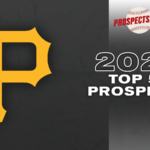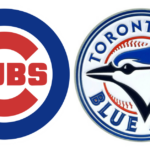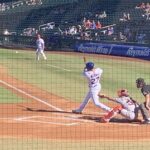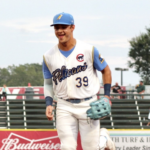
Last spring the Blue Jays made their biggest move of the offseason when they acquired Matt Chapman, fortifying an already excellent offense with arguably the top defensive third basemen in the American League. Chapman had a solid age-29 season, hitting 27 HR with a 115 OPS+ while providing a steady hand at the hot corner.
As Chapman enters his age 30 season and final year of arbitration eligibility, he’s likely looking at big bucks next offseason. Unless Manny Machado opts out of his deal, Chapman will be the clear best 3B on the market. A $25M+ AAV on his next deal is not out of question considering recent deals for players like Kris Bryant and Josh Donaldson, and the Jays have some major financial commitments coming in 2026 (or sooner) when Bo Bichette and Vladimir Guerrero Jr. get their respective pay days. So, what happens if Chapman goes elsewhere? How well are the Jays set up internally to replace him?
A year ago, we might’ve hoped Orelvis Martinez or Jordan Groshans (our #2 and #3 prospects on the Blue Jays preseason 2022 Top 50) would make a leap and cement themselves as a part of the team’s young core. Fast forward to 2023, Groshans is in Miami, and Martinez is coming off a disappointing season that saw him hit 30 HR (awesome!) but with a .203/.286/.446 line, a concerning 28.5% K rate, and questions about his approach (not awesome). In fairness to Orelvis, who remains the team’s #2 prospect on our 2023 Jays Top 50, he’ll be just 21 this year, and the power is undeniable. He just needs more time.
So, let’s take a long look at two other guys who really popped last year: Addison Barger and Damiano Palmegiani.
Addison Barger, SS/3B – Preseason #4
Barger had a breakout 2022 and should be considered for the back end of some top 100 lists. The 2018 6th rounder started the year back at High-A Vancouver and finished the season with an 8 game debut in Triple-A Buffalo. Across 528 plate appearances and three levels, he hit a combined .305/.375/.544 with 25 HR + 33 doubles. He participated in the Arizona Fall League, where he hit just .189/.317/.321 over 53 plate appearances, but he continued to show strong plate discipline with 8 BB against 10 Ks.
Barger showcased improved plate discipline and contact skills year over year, trimming his K% from nearly 33% in 2021 to a respectable 25% last year, improving his swinging strike rate from 18% to 12.6%, while maintaining a solid 9% BB rate. Remarkably, his K and BB rates actually improved with each promotion.
All told, he did more damage more efficiently and earned a spot on the Jays 40-man roster. He’ll likely start the year back in Buffalo, but I expect he’ll get a long look in spring training. If he maintains last year’s gains, and a member of the Merrifield / Biggio / Espinal group is struggling, it wouldn’t shock me to see Barger get an early shot in Toronto. Steamer actually projects him for a 113 wRC+ right now, tied with Daulton Varsho for the 6th best projection on the team. His 50th percentile ZIPS projection forecasts a league average bat, with a projected 106 OPS+. Those are just projections, so take them with a grain of salt, but they provide an indication of his potential viability on the roster.
It wouldn’t be surprising if there’s a needed adjustment period for Barger when he gets to the majors, though. His swing raises a few concerns, as he uses a huge leg kick for timing, takes a very long stride, and takes absolutely vicious cuts at the ball.
It doesn’t seem to affect him getting the barrel to the ball, and I expect he’ll crush pitches at the bottom of the zone, but I wonder if higher end velocity at the top of the zone will give him trouble. Baseball America put a 45 on his hit tool, and I think that’s pretty fair.
I don’t want to sell him short, though. He just had a monster year that included a good sample of games against upper minors competition. The gains in 2022 were very impressive, and I wouldn’t be remotely shocked if he’s in the starting lineup by year’s end. He’s absolutely an option to be the starting 3B in 2024 if Chapman goes elsewhere.
Damiano Palmegiani, 3B/1B – Preseason #18
Palmegiani was a 14th round selection in 2021 out of the JUCO Southern Nevada program, where he posted an obscene .389/.521/.867 line with 26 home runs in 265 PA. Those 26 HR led the NJCAA Division I, and he combined that power with excellent plate discipline, with 36 BB against 38 Ks.
Unfortunately for Palmegiani, he also led the NJCAA in errors (28) and produced an .800 fielding percentage, which helps explain his fall into the 14th round. He doesn’t have an obvious defensive home. Drafted as a 3B, his future is likely at 1B or in LF, where the pressure on his bat will mount. He has the arm for 3B, but scouts have expressed concern about his footwork and hands. The Jays have already begun shifting him around the diamond, as he began seeing time at 1B after a promotion to High-A Vancouver in June, and between A/A+ he appeared at DH in roughly 20% of his games. In short, he seems unlikely to stick as a full-time 3B in the majors. He’s a solid athlete, though, so his continued development in the field will bear monitoring.
Wherever he winds up on the diamond, there are real offensive skills on display. Over 503 PA between Dunedin and Vancouver, Palmegiani hit .239/.343/.475 with 24 HRs + 26 doubles. Look past the batting average, which was weighed down by a .258 BABIP, and there’s evidence of a nice hit tool and discerning eye at the plate. Between the two levels, he carried a 21.4% K% and 10.8% BB%, very solid numbers for an age-appropriate player who also had 50+ extra base hits.
Palmegiani does two things well that are conducive to big power numbers – he lifts and pulls. Over his 272 PA in Vancouver, he produced a 52.1% flyball rate and 45.3% pull rate. For context, among qualified batters in the majors, Kyle Schwarber led the league in flyball rate at 51.1%. (That extreme flyball rate is fair reason to wonder if his low BABIP may be more a feature of his approach than a bug.) This type of approach will likely expose him to better breaking stuff as he faces more advanced pitching, but it’s not out of question that his good batting eye keeps him from chasing too often out of the zone.
Among 28 minor leaguers with over 300 PA that also met the 50% flyball rate and 45% pull rate thresholds, Palmegiani had the 5th lowest swinging strike rate at 10.2% and the 4th lowest K% (he compared favorably to Anthony Volpe, actually), so there is some reason for optimism. It’s an aggressive approach, but he isn’t exclusively selling out for HRs.
Reviewing game footage, Palmegiani shows a compact swing and quick hands. He has a quiet setup with a short leg kick and stride, keeping his head still, but he has a tendency to really fly open trying to get ahead of fastballs. As you’ll see in the game clips below, sometimes that works, but when it doesn’t, he can find himself flailing at hittable pitches.
Also worth noting, it appears he tweaked his swing mechanics during the season, as early video from Dunedin showed him setting up with a fairly open stance while video from Vancouver showed him more square to the plate. Implementing a swing change midseason is no easy task, especially when moving up against more advanced opposition. This could have contributed to his .224/.335/.443 line in Vancouver.
He is very aggressive hunting fastballs but can get beaten at the top of the zone, and in the games I watched, there were times he pulled off well-located sliders and changeups down, in an attempt to turn on a heater.
There are a couple illustrative AB provided below. I went back to a series in July against the Mariners’ Everett squad that featured a great pitching matchup – Prelander Berroa vs. Nick Frasso. Berroa is a legit prospect for the M’s, showcasing a wicked mid-upper 90’s FB, alongside a low 90s cutter/slider and changeup. A good test for Palmegiani.
You see Palmegiani open up and overswing on the second pitch, a hittable slider down in the zone, after taking a fastball down the middle. (Keep that in mind during the second AB below.) Despite looking bad on that first slider, he doesn’t miss one center-cut at the letters, staying back long enough to get out in front for damage. No doubt he can punish mistakes.
Next AB:
Berroa gets him this time on nearly the same pitch Palmegiani hit out in his first AB. Berroa makes him conscious inside with a fastball that bores in heavily and then has Palmegiani way out front on another hittable slider up. He’s trying to turn and burn on a FB, even in a 2-strike count and game situation where just putting the ball in play likely means a run.
Those are just two at-bats, but they offer a glimpse into Palmegiani’s general strengths and weaknesses. He’ll have to show improvement recognizing and handling breaking stuff if he’s going to have success in AA and beyond.
Still, there’s a lot to like. We have limited publicly available data regarding quality of contact, but he played his low-A games in several Statcast parks, so we aren’t flying completely blind. (Huge tip of the cap to Twitter user @ajaypatell8 who scraped this data together and aggregated it into a Google sheet that he shared publicly.) Keep in mind this is not a complete picture of Palmegiani’s batted ball profile (it’s only 137 batted ball events, and it doesn’t include any of his Vancouver PA), but here is the data:
Average exit velocity – 87.4 mph
Max exit velo – 109.2 mph
Average launch angle – 18 degrees
The exit velo numbers are fairly middling for someone who flashes real pop, but if he can continue to lift the ball at his current rates, the lack of top end exit velo likely won’t matter as much. That’s a formula that has worked well for some pros with similar EVs and LAs like Wilmer Flores, Jesus Aguilar, Jordan Luplow. That’s probably the type of hitter we can realistically expect Palmegiani to be. If he’s a relatively versatile corner guy who provides some solid pop, that’s a nice player!
He’s definitely a name to watch in 2023, even if he’s unlikely to be a viable Chapman replacement. That’s okay, though, because he still has a real shot to impact the big league club in 2024 and beyond with improvements in the field and further development of his batting eye.
Daniel is a longtime baseball fanatic, born and raised in North Carolina on a sports diet of Tar Heels basketball and Braves baseball. He has lived in the Austin area since 2006 and now resides just a few miles from the Dell Diamond where the Texas Rangers AAA affiliate Round Rock Express play their home games. He has been playing fantasy baseball for more than 20 years, and over the past 5 years has developed a potentially unhealthy relationship with dynasty baseball. His deepest league is a mostly offline 20 team contracts league with 130-man rosters, and he enters 2023 looking to defend his first league title.





Awesome breakdown!